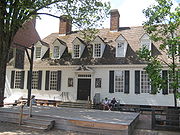
Raleigh Tavern
Encyclopedia

Williamsburg, Virginia
Williamsburg is an independent city located on the Virginia Peninsula in the Hampton Roads metropolitan area of Virginia, USA. As of the 2010 Census, the city had an estimated population of 14,068. It is bordered by James City County and York County, and is an independent city...
, gained some fame in the pre-American Revolutionary War
American Revolutionary War
The American Revolutionary War , the American War of Independence, or simply the Revolutionary War, began as a war between the Kingdom of Great Britain and thirteen British colonies in North America, and ended in a global war between several European great powers.The war was the result of the...
Colony of Virginia as a gathering place for the Burgesses after several Royal Governors officially dissolved the House of Burgesses
House of Burgesses
The House of Burgesses was the first assembly of elected representatives of English colonists in North America. The House was established by the Virginia Company, who created the body as part of an effort to encourage English craftsmen to settle in North America...
, the elected legislative body, when their actions did not suit the Crown. Such dissension became more common between the end of the French and Indian War
French and Indian War
The French and Indian War is the common American name for the war between Great Britain and France in North America from 1754 to 1763. In 1756, the war erupted into the world-wide conflict known as the Seven Years' War and thus came to be regarded as the North American theater of that war...
in 1763 and the outbreak of the American Revolution
American Revolution
The American Revolution was the political upheaval during the last half of the 18th century in which thirteen colonies in North America joined together to break free from the British Empire, combining to become the United States of America...
in 1776.
In 1769, the Raleigh Tavern began its career as a center of sedition when the Burgesses, dissolved because of resolutions against the British Revenue Act, convened in the Apollo Room as the 'late representatives of the people' and adopted the Non-Importation Agreement. This room was the frequent rendezvous of Jefferson, Henry, and other Revolutionary patriots. They met here in 1773 to develop intercolonial committees of correspondence. Dissolved by Dunmore, the Burgesses met again in the Apollo Room in May 1774. The tavern was an institution. Auctions as well as balls were held under the Raleigh's aegis. The Marquis de Lafayette was entertained at a banquet here in 1824, and the building remained in continual use as a tavern until it burned, at the hands of an arsonist, in 1859.
In modern times, the reconstructed Raleigh Tavern, rebuilt in 1932, is one of the more modest but popular attractions of Colonial Williamsburg
Colonial Williamsburg
Colonial Williamsburg is the private foundation representing the historic district of the city of Williamsburg, Virginia, USA. The district includes buildings dating from 1699 to 1780 which made colonial Virginia's capital. The capital straddled the boundary of the original shires of Virginia —...
, a living history
Living history
Living history is an activity that incorporates historical tools, activities and dress into an interactive presentation that seeks to give observers and participants a sense of stepping back in time. Although it does not necessarily seek to reenact a specific event in history, living history is...
museum depicting life in Virginia's colonial capital city. The Raleigh Tavern, an L-shaped white weatherboard building with 18 dormer windows, has been completely reconstructed on its original foundation. It stands on Duke of Gloucester Street in contrast to the elaborate Capitol Building
Capitol (Williamsburg, Virginia)
The Capitol at Williamsburg, Virginia was the first Capitol building in America in 1705. A reconstructed version is a centerpiece of Colonial Williamsburg.-Original building 1705-1780:...
as testament that the work of democracy did not require fancy trappings to function. In the restored Apollo Room, Hilaritas sapientiae et bonae vitae proles (jollity is the offspring of wisdom and good living) is the motto over the mantel.

